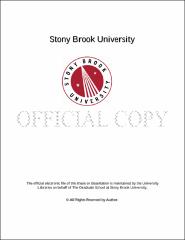| dc.identifier.uri | http://hdl.handle.net/1951/60257 | |
| dc.identifier.uri | http://hdl.handle.net/11401/71518 | |
| dc.description.sponsorship | This work is sponsored by the Stony Brook University Graduate School in compliance with the requirements for completion of degree. | en_US |
| dc.format | Monograph | |
| dc.format.medium | Electronic Resource | en_US |
| dc.language.iso | en_US | |
| dc.publisher | The Graduate School, Stony Brook University: Stony Brook, NY. | |
| dc.type | Dissertation | |
| dcterms.abstract | Mounting evidence reveals the negative impacts of human activities on wildlife populations. However, studies investigating species' responses to human disturbance often rely on patterns of species' richness or abundance, and may not reflect underlying demographic processes. Is there evidence across geographic regions that humans are causing marked changes in species' survival, reproduction, and population growth? Do species' traits influence vulnerability? Can existing theories of ecology serve to predict or explain observable responses to human disturbance? I examined evidence of effects of human disturbance on populations of 24 breeding bird species across the northeastern United States. Based on reported literature and theoretical expectations, I developed hypotheses about effects of human disturbance on demographic parameters. I first tested the hypothesis that human disturbance negatively impacts survival, reproduction, and population growth across species, by determining the importance of human disturbance and the direction of its effect in predicting demographic parameters. I found support for negative impacts of humans on bird populations, but not consistently across species. Next, I tested hypotheses about characteristics that make species vulnerable to human disturbance, by comparing their relationship to each other and the direction of their effect on demographic parameters in the absence and presence of disturbance. Some expected characteristics revealed vulnerability to human disturbance, but the effect was not always consistent across demographic parameters. Lastly, I tested for evidence of a cost of reproduction on survival or future reproduction across species, and asked if human disturbance enhanced costs. A cost of reproduction expected by life history theory was evident across species, but not consistently across different levels of human disturbance. While populations of numerous bird species are declining locally and globally, the extent to which effects of human disturbance are species- specific versus generalizable is not well understood. Mitigating the problem is limited without multi-species analyses of the demographic parameters driving persistence. My results contribute to the body of research measuring human impacts on wildlife populations, demonstrate the value of theoretical and empirical knowledge for predicting and understanding species' responses, and underscore the importance of long-term, large-scale population monitoring programs to collect data integral to addressing these questions. | |
| dcterms.available | 2013-05-24T16:38:18Z | |
| dcterms.available | 2015-04-24T14:47:48Z | |
| dcterms.contributor | Graham, Catherine H | en_US |
| dcterms.contributor | Ak?¼akaya, H. Resit | en_US |
| dcterms.contributor | Levinton, Jeffrey S | en_US |
| dcterms.contributor | Pidgeon, Anna M. | en_US |
| dcterms.creator | Brown, Leone Marion | |
| dcterms.dateAccepted | 2013-05-24T16:38:18Z | |
| dcterms.dateAccepted | 2015-04-24T14:47:48Z | |
| dcterms.dateSubmitted | 2013-05-24T16:38:18Z | |
| dcterms.dateSubmitted | 2015-04-24T14:47:48Z | |
| dcterms.description | Department of Ecology and Evolution | en_US |
| dcterms.extent | 149 pg. | en_US |
| dcterms.format | Application/PDF | en_US |
| dcterms.format | Monograph | |
| dcterms.identifier | http://hdl.handle.net/1951/60257 | |
| dcterms.identifier | http://hdl.handle.net/11401/71518 | |
| dcterms.issued | 2012-12-01 | |
| dcterms.language | en_US | |
| dcterms.provenance | Made available in DSpace on 2013-05-24T16:38:18Z (GMT). No. of bitstreams: 1
StonyBrookUniversityETDPageEmbargo_20130517082608_116839.pdf: 41286 bytes, checksum: 425a156df10bbe213bfdf4d175026e82 (MD5)
Previous issue date: 1 | en |
| dcterms.provenance | Made available in DSpace on 2015-04-24T14:47:48Z (GMT). No. of bitstreams: 3
StonyBrookUniversityETDPageEmbargo_20130517082608_116839.pdf.jpg: 1934 bytes, checksum: c116f0e1e7be19420106a88253e31f2e (MD5)
StonyBrookUniversityETDPageEmbargo_20130517082608_116839.pdf.txt: 336 bytes, checksum: 84c0f8f99f2b4ae66b3cc3ade09ad2e9 (MD5)
StonyBrookUniversityETDPageEmbargo_20130517082608_116839.pdf: 41286 bytes, checksum: 425a156df10bbe213bfdf4d175026e82 (MD5)
Previous issue date: 1 | en |
| dcterms.publisher | The Graduate School, Stony Brook University: Stony Brook, NY. | |
| dcterms.subject | Ecology--Conservation biology | |
| dcterms.subject | birds, conservation, disturbance, life history, trade-offs, urbanization | |
| dcterms.title | Human disturbance and birds of the Northeast: What makes some species decline, while others are just fine? | |
| dcterms.type | Dissertation | |

